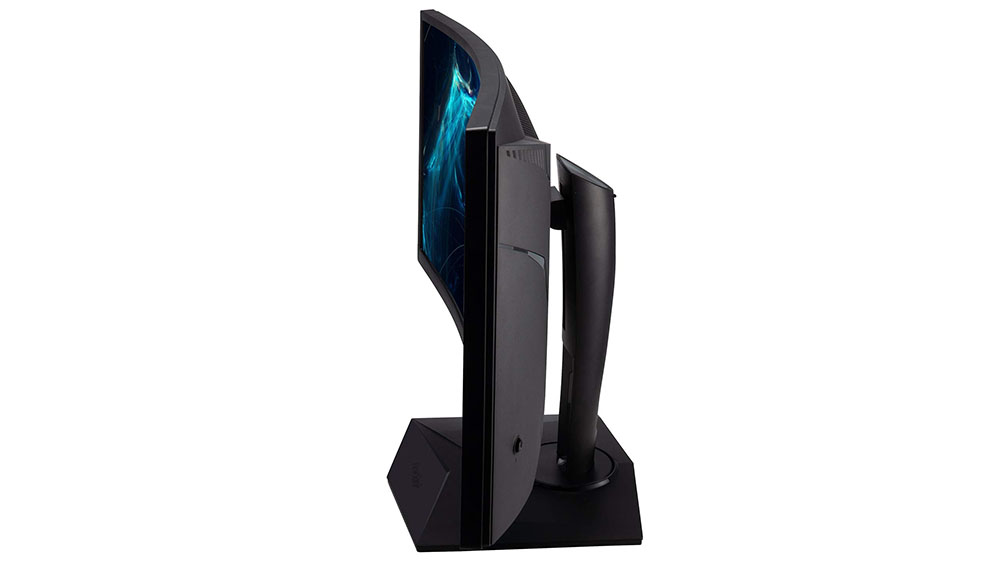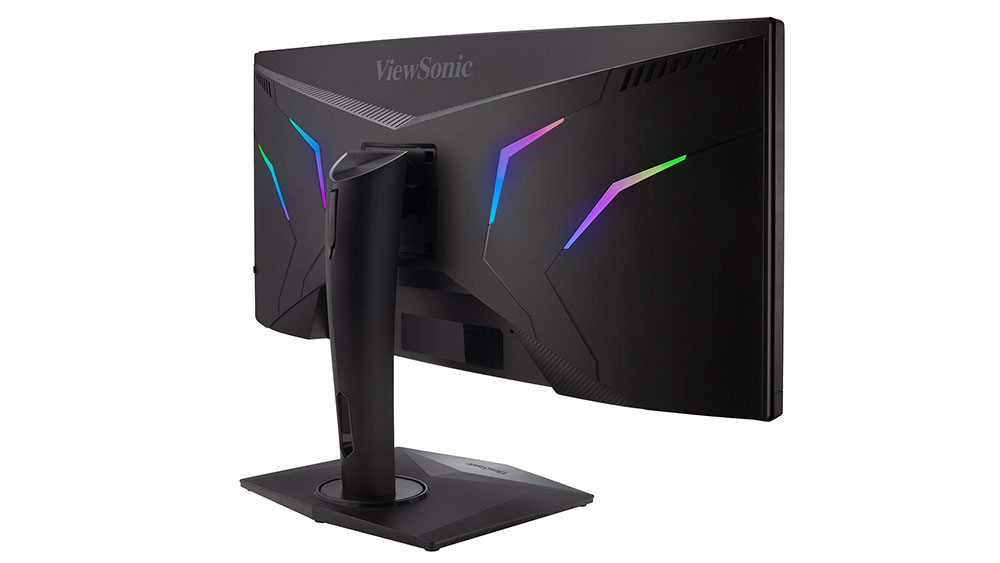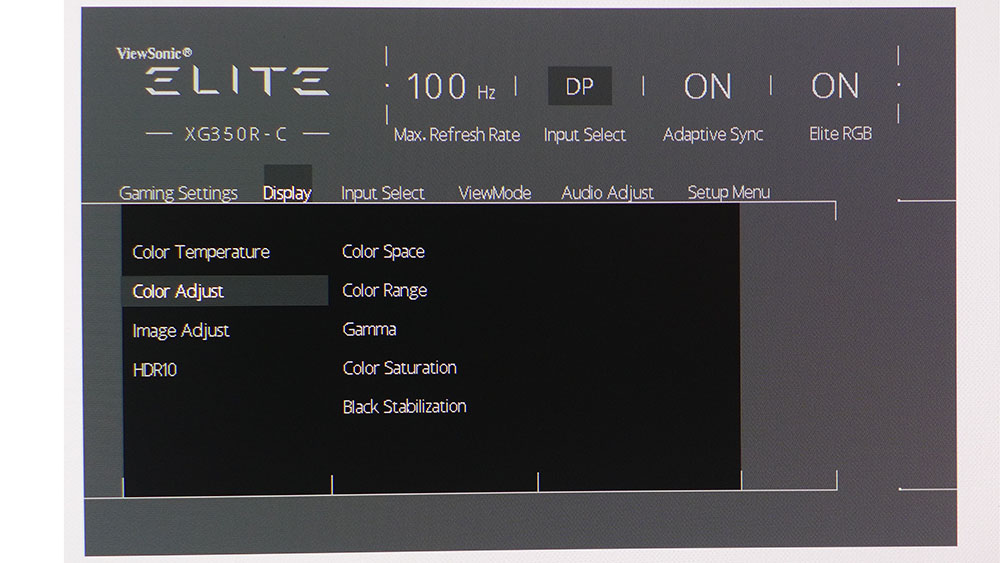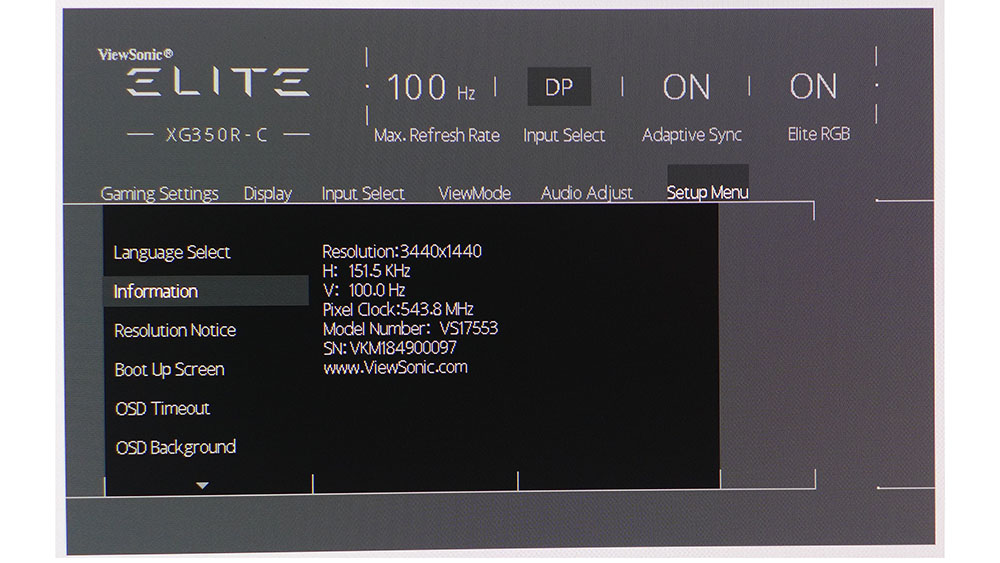Tom's Hardware Verdict
While the ViewSonic XG350R-C doesn’t offer any improvement with HDR material, it delivers a superb gameplay experience, thanks to running both flavors of adaptive sync, as well as bringing excellent contrast and accurate color.
Pros
- +
Excellent contrast and accurate color
- +
FreeSync (and can run G-Sync unofficially)
- +
Fast response from 100 Hz refresh rate
- +
Good build quality
- +
Loud speakers
Cons
- -
No additional contrast in HDR mode
- -
No extended color
Why you can trust Tom's Hardware
Features and Specifications
HDR is still a somewhat elusive technology among gaming monitors. While there are plenty of choices, there is still a divide between displays that simply support HDR signals and those that can truly do the tech justice. In the latter category are the premium priced zone-dimming models, like Asus ROG Swift PG27UQ and Acer Predator X27. But neither of these offer the wraparound experience of a curved ultra-wide screen.
If you’re looking for an ultra-wide gaming monitor with HDR, your choices just increased, thanks to ViewSonic’s Elite XG350R-C. It boasts a 35-inch VA screen with 2,500:1 claimed contrast. It also delivers HDR10, AMD FreeSync and a 100 Hz refresh rate. And, although not officially certified by Nvidia as being G-Sync Compatible, Viewsonic says, and our testing confirmed, you can run G-Sync on it.
ViewSonic Elite XG350R-C Specifications
| Panel Type and Backlight | VA / W-LED, edge array |
| Screen Size and Aspect Ratio and Curve Radius | 35 inches / 21:9, Curve Radius: 1800mm |
| Max Resolution, Refresh Rate and Pixel Density | 3440x1440 @ 100Hz, FreeSync: 48-100Hz |
| Native Color Depth and Gamut | 8-bit / sRGBHDR10 |
| Response Time (GTG) | 3ms |
| Brightness | 300 nits |
| Contrast | 2,500:1 |
| Speakers | 2x 5w |
| Video Inputs | 1x DisplayPort 1.4, 2x HDMI 2.0 |
| Audio | 1x 3.5mm output |
| USB | 1x up, 3x down |
| Power Consumption | 45.3w, brightness @ 200 nits |
| Panel Dimensions(WxHxD with base) | 33.4 x 17.1-20.9 x 12 inches / 848 x 434-531 x 305mm |
| Panel Thickness | 5 inches / 127mm |
| Bezel Width | Top/sides: 0.5 inch / 13mm, Bottom: 0.8 inch / 21mm |
| Weight | 29.7 pounds / 13.5kg |
| Warranty | 3 years |
To be clear, the XG350R-C is not a budget panel. At this writing, it’s selling for around $630. But that is far from being the most-expensive curved ultra-wide display out there. And our testing revealed you don’t give up much to get 35 inches of gaming goodness.
First, the high-contrast VA screen: We’ve always favored VA technology over IPS and TN, simply because it delivers at least double the native dynamic range. That makes the omission of a zone-dimming backlight a bit easier to bear. We’re not saying it will match the stunning images that come from a FALD (full-array local dimming, like the ROG Swift PG27UQ and Predator X27 have). But you will get excellent image depth in both SDR and HDR modes.
The XG350R-C has plenty of gaming cred, thanks to a 100 Hz native refresh rate and FreeSync available from 48-100 Hz. And there’s a bonus here: Our testing confirmed that the XG350R-C can run G-Sync flawlessly, although Nvidia has not officially certified it as being able to do so. To learn how to do this, check out How to Run G-Sync On A FreeSync Monitor, and to see how the two adaptive sync flavors compare, see Nvidia G-Sync vs. AMD FreeSync: Which Monitors Perform Better?
In terms of HDR, the monitor supports HDR10 signals through its HDMI 2.0 and DisplayPort 1.4 inputs, but you can’t get HDR while using FreeSync (or G-Sync for that matter). It does not have sufficient bit-depth, nor does it support FreeSync 2 HDR.
In addition to its performance features, the XG350R-C sports a lighting system called Elite RGB. It consists of a slick LED effect on the panel’s backside that coordinates with LED-equipped hardware, like coolers, keyboards and power supplies. You can check out compatible hardware on ViewSonic’s website. Basically, anything that interfaces with Razer, Thermaltake and Cooler Master software will work with ViewSonic’s Elite RGB system.
Get Tom's Hardware's best news and in-depth reviews, straight to your inbox.
Coupled with tank-like build quality, the XG350R-C’s price seems like a good value. It has a slick lighting effect across the back, a headphone hook and all the on-screen display (OSD) options a gamer could ask for. All that remains is for us to put it through thorough testing.
Unpacking and Accessories
At nearly 30 pounds, the XG350R-C exudes quality as soon as you free it from its carton. The only assembly required is to attach the substantial base to the upright with a captive bolt. The stand pivots 90 degrees, but this is merely for packing purposes. You can’t actually rotate the panel to a true portrait mode in its stock form.
The cable bundle includes HDMI, DisplayPort and USB. A large brick serves as the external power supply. Documentation is available on ViewSonic’s website.
Product 360





All Credit: ViewSonic
The XG350R-C is a massive monitor with chunky, almost industrial styling.There’s no attempt to be slim, and the panel is a substantial 5 inches thick. The stand is equally solid, with firm movements that feature just under 4 inches of height adjustment, along with 45 degrees swivel in each direction and a 15-degree back tilt with 5 degrees forward. There is no wobble, and the panel stayed in place no matter how much we pounded on the table during gameplay.
The curve is a tight 1800mm radius, which enhances the wraparound effect. Since you’re getting high resolution at 3440 x 1440 pixels (107ppi), you can sit nice and close and fill your peripheral vision with the gaming environment, or your favorite spreadsheet.
In back is a slick lighting effect with four LED-lit chevrons. By default, they pulse gently and change color smoothly. If you use the Elite RGB feature, the lights will coordinate with other supported LED-equipped hardware for an integrated effect. Also around back is the one and only control joystick. It accesses all monitor functions, including the power toggle. It’s reasonably intuitive and can make short work of calibration or gaming tweaks.
The input panel has two HDMI 2.0 ports and one DisplayPort 1.4, plus one upstream and three downstream USB 3.0 connections. Headphones can be jacked into the provided 3.5mm plug.
The XG350R-C also includes two of the loudest speakers we’ve encountered on a monitor. They’re driven by 5-watt op-amps and deliver surprisingly good sound at high volumes without distortion. You won’t be bowled over by their bass production, but they are far better than what’s found in most other monitors.
OSD Features
To activate the OSD, reach around the back-right, and click the small joystick. The menu has it all for a gamer or tweaker. The Gaming Settings sub-menu has two settings memories, along with gaming modes you can set independently from the picture presets. You can also turn adaptive sync on or off. Turning it on will make the monitor visible to an Nvidia graphics adapter, and if you have the proper drivers from Nvidia, it will run G-Sync. We confirmed this but, again, Nvidia hasn’t added this monitor to its official list of G-Sync Compatible displays.
The Display menu has a full set of image tweaks, including six color temperature and six gamma presets. The picture modes are in a separate menu, called ViewMode. There are six choices, but you can dial in any preferences you want in the default Standard mode.
We calibrated our XG350R-C sample, but in practice, the gains were quite small. There are a few anomalies in grayscale tracking that we’ll detail on page three, but for the most part, this monitor delivers good color out of the box.
The signal info screen shows basic values for resolution and refresh rate. If HDR is running, it will tell you that at the bottom. Along the top of every menu screen is a large indicator with refresh rate, active input and the status of both adaptive sync and the Elite RGB lighting effect.
Setup and Calibration
You can calibrate the XG350R-C in the Standard picture mode by choosing the Full Color Control option in the color temp menu. Adjusting the RGB sliders is something of a compromise because we were unable to correct errors at every brightness step. We achieved good tracking in the middle tones from 40-60 percent, but the darkest and lightest areas remained slightly green. Gamma tracked well in all cases, and color gamut accuracy is superb.
While you can enjoy the ViewSonic XG350R-C without calibration, we suggest trying our settings. The improvement is small but visible. Here are the settings we used during our tests:
| Viewsonic XG350R-C Calibration Settings | |
| Brightness 200 nits | 50 |
| Brightness 120 nits | 28 |
| Brightness 100 nits | 21 |
| Brightness 80 nits | 13 |
| Brightness 50 nits | 0 |
| Contrast | 70 |
| Gamma | 2.2 |
| Color Temp User | Red 100, Green 95, Blue 98 |
Gaming & Hands-on
The XG350R-C supports HDR10 content, but since it has an edge backlight and no dynamic contrast feature, it won’t deliver any more contrast in HDR mode than it does in SDR. Turning on HDR in Windows only had a subtle effect. It wasn’t better or worse, just different. There’s no extended color either; the monitor renders sRGB regardless of signal type.
Gamers have a choice to make. If you enable HDR, you can’t have FreeSync (or G-Sync). After a bit of trial and error, we decided using adaptive sync was the best way to play Call of Duty: WWII. HDR gaming on this monitor worked but added nothing to the experience. FreeSync, however, ensured smooth motion right up to 100 Hz. With a PC running an AMD Radeon R9 285 graphics card there were no tearing artifacts. We were able to keep the refresh rate above 48 Hz by turning down detail one level. If you have a fast AMD card, the gaming experience will equal that of a G-Sync system.
With G-Sync we got slightly higher refresh rates, up to 100 Hz, thanks to a Nvidia GeForce GTX 1080 Ti Founders Edition graphics card.
Video quality was superb with high contrast, vivid color and perfect motion with no artifacts. Response was Jedi-like, which is expected when you can keep the frame rate at or near 100 frames per second (fps). Even though we were limited to sRGB color, we didn’t miss the extra red and green afforded by DCI-P3. The XG350R-C is a superb panel with some of the best color and accuracy we’ve seen. Textures popped from the screen, and flesh tones looked perfectly natural. We were especially impressed during the cut scenes, when rendered characters looked almost too realistic. War is no joke when you’re waging it on this monitor.
MORE: Best Gaming Monitors
MORE: How We Test Monitors
MORE: All Monitor Content

Christian Eberle is a Contributing Editor for Tom's Hardware US. He's a veteran reviewer of A/V equipment, specializing in monitors. Christian began his obsession with tech when he built his first PC in 1991, a 286 running DOS 3.0 at a blazing 12MHz. In 2006, he undertook training from the Imaging Science Foundation in video calibration and testing and thus started a passion for precise imaging that persists to this day. He is also a professional musician with a degree from the New England Conservatory as a classical bassoonist which he used to good effect as a performer with the West Point Army Band from 1987 to 2013. He enjoys watching movies and listening to high-end audio in his custom-built home theater and can be seen riding trails near his home on a race-ready ICE VTX recumbent trike. Christian enjoys the endless summer in Florida where he lives with his wife and Chihuahua and plays with orchestras around the state.



